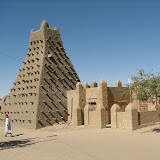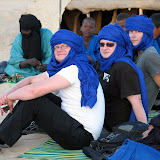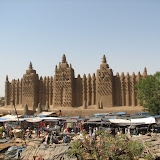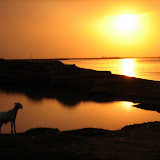Well, this time I think I might be pushing my readers’ patience when it comes to updating my blog. My daily schedule rarely lets me write these day-to-day posts, that normally characterize a blog (and neither does my internet-connection either), which is why these long updates arrive at a less than frequent pace. Some day, it would be nice to have sufficient time – or energy – to be a properly active blogger, but that day lies a bit far ahead in my case, I’m afraid…
- Well, all apologies aside, let me try to make up for several weeks (months?) of missing activity…
As I have mentioned before, I had the pleasure of visiting friends for almost 3 weeks before Xmas. It was truly a joy spending time with some old friends again, not just for the socialising (although that was very much needed) but also because I find, that one enjoys the great experiences down here a lot more, when one has someone to share them with. Thus, apart from daytrips in Ouaga, Banfora and the likes, we also enjoyed an extended weekend trip in Mali with visits to Timbuktu, Mopi, Djenne and San as well as some time in the Malian capital, Bamako.
Since I had to work through the whole stay of my friends, they also had quite a bit of time to themselves, which they bravely used to go exploring on their own – they (inadvertently, I guess) even visited the poorest and oldest quarter in Bobo – the neighbourhood with the worst reputation in this part of BF, where very few white guests normally go – and they did it on foot! Anyway, the fact that nothing happened, except for the unavoidable cries of “Tuab, tuab” (which means “whites, whites” in one of the local languages), just underlines that Burkina Faso in general – and Bobo in particular – has to take the price as the most peaceful place in West Africa. The general mentality is simply so very relaxed and pleasant, that one cannot help admiring it – because a lot of these people really don’t have a lot going their way in life.
Going on the big one in Mali
The round-trip in Mali was quite an experience. I have already posted quite a few photos on my new online photo album – http://picasaweb.google.dk/Rejseneger - from the different places we visited, but I think the trip deserves a few comments in writing as well. When I first booked the trip long before my friends had even arrived, it was not without a certain scepticism towards paying a lot of money (and quite a bit of that in advance) to a – to me – unknown Malian for a trip that amongst other things involved 2 domestic flights, 2 walks through the poorest neighbourhoods in Mali as well as a camel-ride on the border of the Sahara. All of my concerns proved to be falsely placed, though, because what we experienced was well worth the expensive ticked price – well worth it indeed.
After a night or two in Bamako – where I had to go for work anyway – that included outings to see the city from above, the presidents little “hut”, the artisans market (especially the carvings and the bronze there is exquisite – my mate Torben got his hands on two absolute masterpieces), my favourite bar (where a double whisky costs 15us, so we stuck to the beers) as well as a crossing of the Niger river at surface-level on old concrete blocks, we were ready to take on the adventure of the legendary Timbuktu – or Tomboctu, as it’s called in the French-speaking Mali.
This town is nothing less than amazing. Placed as close to the middle of nowhere as one can imagine, this city has such a long and incredible history, that one can truly feel the weight of the ages on ones shoulders, as one strolls down the cobbled streets in the city centre. Timbuktu used to be amongst the intellectual centres of the world before a jealous Moroccan king decided to sack the city and kidnap all the professors and scholars who worked there to bring them back to Morocco. Literally hundreds of thousands of students used to take one of the two equally perilous journeys either through the Sahara on the back of a camel or by the grandiose Niger river by tiny boats to go and study there. The city was mentioned in so many old documents and surrounded by such mystery, that for many years, the National Geographic Society in London had a price of ten thousand pounds in gold for the man who could prove that the city of Timbuktu actually existed!!!

After arriving there we had a very interesting guided tour through the old town seeing markets, mosques, historical points of interests etc. A great experience – I mean – if one has a bit of a travel-gene in ones body, isn’t it amongst the greats to be able to say that one has been to Timbuktu?! When I become an old toothless grandfather, I will be telling my grand-kids about it, that’s for sure!
An ‘excuse’ owed to an unknown association
Before taking my story further, I apparently have to issue an official excuse to DDF… If that name doesn’t ring a bell, I can tell you the abbreviation stands for ‘Dansk Donaldist Forening’ – Danish Donaldist Association/Union. If you, dear reader, aren’t very confused by now, I’d be surprised.
I know I was…
DDF is a group of people who apparently enjoy the wonders of Donald Duck to near-religious extremes. The whole, bizarre story took its beginning when I ‘Google’d’ the name ‘Rejseneger’ – just to check its originality. Apart from my blog appearing on the list of hits, to my great surprise I found a mention of my site as a part of a grand discussion on DDFs webpage. Of course I had to check it out, and it has apparently greatly offended members of this – sorry guys – very nerdy union, that I in a previous log-entry have mentioned, that “Timbuktu lies in Mali in stead of in the (fictional) country ‘Langtbortistan’”. I never, ever thought, that people would spend their time criticising something as far out as correct usage of fictional geography – much less getting sufficiently agitated as to be calling me an idiot for such a ‘horrible’ mistake. Well, not mentioning the fact that I think the editorial freedom of blogs should be very big indeed, I shall happily give my excuses for having the before mentioned remark taken so insanely literal and serious… “Sorry..!”
Should you wish to see this insanity for yourself, the link is: Http://ddfr.dk/forum/viewtopic.php?pid=17505#p17505
As a postscript I have to mention that the initial post in this string mentioned that I have been published in something as famous as “Herning Folkeblad” (a tiny newspaper that I have never even seen a copy of in my life). I don’t know what is worse; Criticising people for not knowing their IMAGINARY AND FICTIOUS places’ proper geographical position, falsely accusing someone of having published this in an almost unknown newspaper or taking comics religiously serious? I leave that judgement to you, dear reader, and I hope that this will someday hit the website of DDF as well. If nothing else, I promise you, that I had the laugh of the week when I discovered this
The Sahara seen from the back of a camel.
So, after this short excuse, let’s get back to what this blog is all about – great experiences on an equally great continent!
After an incredibly interesting day walking through Timbuktu – including a visit to the house of the first white man ever to reach the city (who was unfortunately beheaded by the local Touareg-people, so he never got his gold) and a lunch with plenty of sand in it at the local market (it is said, that if bread in Timbuktu isn’t crunching with sand, it’s not properly prepared), we were ready to take a late afternoon ride out into the outskirts of the Sahara by camel… Great authentic experience – right up until the cell-phone of one of our camel-guides rang! Amazing to have such a clash of new and old, I remembered thinking. The people there live in huts made from braided straw or patched camel hides depending on their financial means as they have for centuries, but at the same time, the local cell phone antenna mounted in the centre of Timbuktu provides ample coverage for at least an hour’s camel-ride into the desert. A bizarre experience in many ways.
When we reached the small settlement we were there to visit and share some tea at (I believe I have covered the Malians’ addiction to tea in a previous post on this blog), the circus started. Many years ago, the Touareg people lived as kings of the desert, keeping a whole tribe as their slaves (they are called the Bella and in spite of their status as free people today, they still live in the most extreme degree of poverty), and making big profits on transporting salt in great caravans travelling by night across the Sahara. I believe it must be this history, which has given the Touareg their image as the “proud men of the desert” that one sees pictured in both movies and books aplenty – VW has even released a car-model called Touareg, I believe. This very glorified image deserves heavy revision today, though. Here we have a people, which used to make a living by either crossing the Sahara, burning or robbing villages (to ensure a plentiful supply of slaves) or just simply breeding and selling camels.
Today, Maersk Line can put a container of salt in Timbuktu in a matter of days and at a fraction of the cost of a trip on the back of a camel, and slavery has thankfully been prohibited even in Mali. This leaves this ‘proud’ people in a position where they have to adapt to changes, and this is something they in my view are extremely poor at.
Apparently it is – according to traditional Touareg beliefs - unworthy for a man to work, except if one does camel caravans, slaving or traditional handicrafts. Since the 2 first options don’t exist anymore, the third option – along with begging, which apparently is a perfectly fine way of making a living – seems to be the only way these people try to survive today. There is literally NOTHING left of this once ‘proud’ culture in my humble opinion. They are – and I’m sorry for the harshness of this wording – reduced to a people of peddlers and beggars. Whenever you meet a Touareg in West Africa today, you’d better start saying ‘no’ right away, unless you want to end up with a worthless piece of ‘silver’ jewellery or an even more useless sabre made of ’real’ iron…
The village we visited consisted of kids trying to get in front of our cameras only to demand money for the photo-op and then plenty of eager salesmen who wanted to fill our pockets with ridiculously poor trinkets of questionable value. Some of the traditional art of the Touareg is actually very beautiful, but what these guys were selling was frankly speaking just junk.
At least the tea was good, and the sunset beautiful…

By the way, if you try to ride a camel the way one rides a horse at a trot, it can result in heavy blistering in places I really would prefer to leave unmentioned in this post…
Mopti and Djenne!
After a reasonable meal at the hotel in Timbuktu (although Torben kept longingly mentioning the wonderful vegetable soup his girlfriend makes him) and a good nights sleep, we were transported (at break-neck speed I must add) to the airport and our second flight with the wonderful national Malian airways. They proved to be a big surprise to me, I must say. The other local flights I have taken down here have left me with fear bordering phobia against flying in WAF. I promise you, dear reader, that the planes still in operation down here wouldn’t be allowed to leave the runway – much less the hangar – in any western country. They are old, worn and in a horrible state of maintenance, they most often only fly with one pilot (allegedly the one in Ghana has a drinking problem too, to make matters worse) and there is quite a bit of turbulence over the West African continent. All in all a wonderful combination that normally makes me do a pope-imitation every time I successfully survive a flight down here. All of this being said, however, the Malian airline proved to be a very pleasant experience. The plane was new, apparently in good shape and there were two (2!) guys in the cockpit! The flights are low altitude flights, so the views were amazing, flying over the big deltas and green areas bordering the ever impressive river Niger.

After having gotten our luggage in no time (another positive surprise), we entered what must be considered to be one of the smallest airports in the world, where another guide was waiting with a 4x4 to drive us into Mopti town. The entry into Mopti is impressive – the road crosses a big, dammed (no, not damned!) delta, where you have green farmland on one side and a big lake on the other. It is also where you can experience a Mopti carwash! They have a ramp down into the water, and they simply back the vehicles down it until they are parked out in the water where the hand-washing begins! An interesting sight, I must say.
We started the day with a long walk through Mopti, starting at the central Mosque in town, and then walking through poorer and poorer neighbourhoods for what seemed like hours. When you are a tourist, it’s sometimes quite hard to be left alone – and much less be allowed to take photos – but since the tour was guided, it proved to be a very easygoing way of experiencing the town. The guide ensured us almost total freedom during the tour, and he was quick to tell us if there was anything we couldn’t do. We saw markets, narrow alleys, open sewers and a multitude of welcoming people – constantly chanting the now much known ‘tuab, tuab’. Fortunately, the guide taught us to reply in fashion by shouting ‘frarafin, farafin’ – meaning ‘Africans, Africans’ – which resulted in a lot of laughter and smiles.

A sight with a huge impact
The part of the whole trip, that I think had the biggest impact not only on my visiting friends but on me as well, was when we finally reached the poorest quarter of Mopti, home of the before mentioned Bella tribe – the former slaves of the Touareg. After having seen continuously poorer and poorer neighbourhoods, we thought the tour was coming to its conclusion as the open sewer ended at a road crossing. We were very surprised to see that this was not the case at all… After crossing the road, we descended into what must be the very extremes of human poverty. The now “free” tribe of the Bellas in Mopti, today still regarded as holding the lowest position in the social hierarchy, now try to survive on the remains and wastes from the city. I have seen poverty in many forms on my different travels, but this place takes the ‘price’. Torben took several photos and a bit of film as well – I will see if he agrees to a posting of it here – it is needed, because words have a hard time describing what we saw at this place. The luckiest had what could pass for a hut, whilst the poorest simply slept on the ground in the midst of waste, sewage and animal manure. Kids with big bellies were playing in the – pardon my French – shit, and the whole place had an eerie atmosphere of despair and misery.
Torben let me post the video. "Enjoy":
After this, the trip led us to a tour of the port – Mopti’s business core – where longtail-boats much like the ones seen in the far east were aplenty in all different sizes. They all held a multitude of people, however, and even the tiniest ones apparently served as the only home for the families on board. They live their entire life on the river and only come to shore to sell their excess catches and to by the few necessities the river cannot provide them. The whole port has a seething, bustling atmosphere and is a great experience to see. We were all exhausted now, physically but especially mentally, so we had to decline an offer of lunch at the port in order to go to the hotel and rest. Particularly the walk through the Bella-neighbourhood weighed like a tonne on the mental scale, so a few hours were spent resting and discussing the sights of the day – it was great having friends there to share the experience with – because this day is not one easily forgotten.

The afternoon and evening was passed sailing on the Niger and its tributary – where Kasper found out, that he needs to have kids (and soon, too!) when a small girl instantly fell in love with him during a visit to one of the many islands in the Niger-delta. I believe that a few photos of the two together can be found on the previously mentioned web-album. In the end, he couldn’t help handing her a small note (1000 CFA - less than 2 euros) that promptly resulted in her running away with the note above her head shouting jubilantly - and a few minutes later, the entire village was headed in our direction to see if more gifts were available. In stead of waiting for this we quickly made our escape on the boat and we spent the last minutes of sunlight on the calm waters of the great Niger.

A mosque to remember
The distance between Mopti and Djenne were covered by car – thankfully this time with a less psychotic driver – and since we only had a few hours in Djenne – we took an early start out of Mopti.
Djenne is considered a world heritage monument in general – and the great mosque in particular. It’s the world’s larges structure built out of sand and mud – and it has a very interesting history. Originally built as a temple for the local animist beliefs, it has been sacked and burned on more than one occasion – and has during the last a little more than a 100 years served as a Muslim mosque in its current form. Again, we profited a lot from having a local guide, who not only knew a lot about Djenne and its history – he could also open a lot of doors and ensure a lot of good photo opportunities for us.

The tour of Djenne also brought professional input for Nis who, being a plumber, with great interest could look at the multi-storey toilets attached to the exterior of the houses in Djenne. The great bit about them was that they were not connected to a drain! Therefore, we were explained, the inhabitants of the house had to empty this massive 4 metre tall loo every now and then by literally breaking a hole at the bottom and manually removing the contents. This information immediately spawned a big discussion in our group how this chore was allocated. Our best guess would be that the last man in does the job – I’ll leave further details of our discussion to the imagination of you, dear reader.
In order to avoid that the description of Djenne ends up being rather latrine, I will add that we had a very interesting tour of the town, with plenty of sights and observations. Very much worth a visit, indeed.
In the afternoon, another drive was requested to get us back to Segou for a few nightcaps on the bank of the river and a well deserved rest. My driver had taken the trip Bamako-Segou on his own, so we could return to Bobo during the morning of the following day.

Thus ends yet another of my far too voluminous posts – I know that a lot more frequent and shorter (!) posts would be ideal – I hope you enjoyed it. Don’t hesitate to post comments or send request if there are photos you’d like to see posted here. I have been having continuous problems with the programme I use to upload photos to Blogger with, so please forgive me, if photos go missing or aren’t posted at all.
Finally, I include direct links to some of my photoalbums online:





Ingen kommentarer:
Send en kommentar